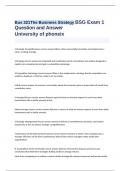Introduction:
When it comes to software development, selecting the appropriate software development
model and systems analysis tools is vital for effectively implementing the new E-Card System
for Cartes de Mode. This paper examines the fundamental concepts of software
development models, investigates several systems analysis tools and methodologies, and
evaluates their appropriateness for modelling business processes in the context of the E-
Card System project, with the goal of guaranteeing that the system enables the customer to:
create a diary to record events such as birthdays
access a quick view of events and reminders
●access a quick view address book
●send automatic reminders of the diary events, 3 days before the event
●link to preferred social media
●view on both mobile devices and desktop pc
●send e-cards from the desktop
●receive card receipt confirmation
●access payment facilities
●have a secure login
1. Principles of Software Development Models:
The Waterfall Model is a conventional software development approach that follows a linear
sequential flow and consists of discrete phases: requirements, design, implementation,
testing, installation, and maintenance. Regarding the design of business processes for the e-
card system "Cartas de Mode," the Waterfall Model presents both benefits and factors to be
taken into account. The Waterfall Model can give a structured approach for implementing a
system that enables consumers to construct a diary, access event reminders, maintain an
address book, and participate with social media. The first stage of requirements
specification involves describing features such as creating a diary and having quick-view
capabilities. The ensuing design process will prioritise the user interface and experience,
guaranteeing interoperability with both mobile devices and desktop PCs. Implementation
encompasses the process of converting these designs into a fully operational system, while
testing assures the dependability of features such as automated reminders and secure
logins. The installation and maintenance phases ensure the continuous working of the
system. The Waterfall Model is well-suited for small-scale projects with steady
requirements, which matches with the focused scope of the Cartas de Mode e-card system.
, This system emphasises personalised animated cards and integration with social media.
Nevertheless, it is crucial to acknowledge that the Waterfall Model may encounter obstacles
in dynamic contexts where needs alter, as its sequential character may result in difficulty in
adapting to modifications. To summarise, although the Waterfall Model provides a
systematic method for constructing the specified e-card system, organisations should be
cautious of its potential rigidity when confronted with changing requirements.
Systems Life Cycle:
The Systems Life Cycle model, specifically the phased method, is a reliable framework for
developing and implementing the Cartas de Mode e-card system. This system aims to
improve customer experiences in event planning and expressing sentiments. The successive
processes of definition, research, analysis, design, implementation, testing, documentation,
evaluation, and maintenance are well-coordinated with the complex functionalities that the
system intends to provide. The iterative structure of the method is particularly
advantageous for a project of this sort, as it allows for the incorporation of modifications
and improvements at every stage. During the definition phase, the system's goals are
established to ensure a thorough comprehension of client requirements in the creation of
diaries, obtaining concise overviews of events and reminders, managing contact lists, and
incorporating social media functionality. The investigation and analysis phases focus on
understanding customer requirements and preferences, which are crucial for implementing
features such as automated reminders and cross-platform compatibility on both mobile and
desktop devices. The design and execution phases convert these insights into a user-friendly
interface, while testing ensures the stability and operation. Documentation provides explicit
instructions, while evaluation facilitates ongoing enhancement. System maintenance
ensures the durability and flexibility of the system. The implementation of the structured
Systems Life Cycle model is crucial for guaranteeing the triumph and durability of the Cartas
de Mode firm by methodically tackling every part of its intricate functionality.
When it comes to software development, selecting the appropriate software development
model and systems analysis tools is vital for effectively implementing the new E-Card System
for Cartes de Mode. This paper examines the fundamental concepts of software
development models, investigates several systems analysis tools and methodologies, and
evaluates their appropriateness for modelling business processes in the context of the E-
Card System project, with the goal of guaranteeing that the system enables the customer to:
create a diary to record events such as birthdays
access a quick view of events and reminders
●access a quick view address book
●send automatic reminders of the diary events, 3 days before the event
●link to preferred social media
●view on both mobile devices and desktop pc
●send e-cards from the desktop
●receive card receipt confirmation
●access payment facilities
●have a secure login
1. Principles of Software Development Models:
The Waterfall Model is a conventional software development approach that follows a linear
sequential flow and consists of discrete phases: requirements, design, implementation,
testing, installation, and maintenance. Regarding the design of business processes for the e-
card system "Cartas de Mode," the Waterfall Model presents both benefits and factors to be
taken into account. The Waterfall Model can give a structured approach for implementing a
system that enables consumers to construct a diary, access event reminders, maintain an
address book, and participate with social media. The first stage of requirements
specification involves describing features such as creating a diary and having quick-view
capabilities. The ensuing design process will prioritise the user interface and experience,
guaranteeing interoperability with both mobile devices and desktop PCs. Implementation
encompasses the process of converting these designs into a fully operational system, while
testing assures the dependability of features such as automated reminders and secure
logins. The installation and maintenance phases ensure the continuous working of the
system. The Waterfall Model is well-suited for small-scale projects with steady
requirements, which matches with the focused scope of the Cartas de Mode e-card system.
, This system emphasises personalised animated cards and integration with social media.
Nevertheless, it is crucial to acknowledge that the Waterfall Model may encounter obstacles
in dynamic contexts where needs alter, as its sequential character may result in difficulty in
adapting to modifications. To summarise, although the Waterfall Model provides a
systematic method for constructing the specified e-card system, organisations should be
cautious of its potential rigidity when confronted with changing requirements.
Systems Life Cycle:
The Systems Life Cycle model, specifically the phased method, is a reliable framework for
developing and implementing the Cartas de Mode e-card system. This system aims to
improve customer experiences in event planning and expressing sentiments. The successive
processes of definition, research, analysis, design, implementation, testing, documentation,
evaluation, and maintenance are well-coordinated with the complex functionalities that the
system intends to provide. The iterative structure of the method is particularly
advantageous for a project of this sort, as it allows for the incorporation of modifications
and improvements at every stage. During the definition phase, the system's goals are
established to ensure a thorough comprehension of client requirements in the creation of
diaries, obtaining concise overviews of events and reminders, managing contact lists, and
incorporating social media functionality. The investigation and analysis phases focus on
understanding customer requirements and preferences, which are crucial for implementing
features such as automated reminders and cross-platform compatibility on both mobile and
desktop devices. The design and execution phases convert these insights into a user-friendly
interface, while testing ensures the stability and operation. Documentation provides explicit
instructions, while evaluation facilitates ongoing enhancement. System maintenance
ensures the durability and flexibility of the system. The implementation of the structured
Systems Life Cycle model is crucial for guaranteeing the triumph and durability of the Cartas
de Mode firm by methodically tackling every part of its intricate functionality.










